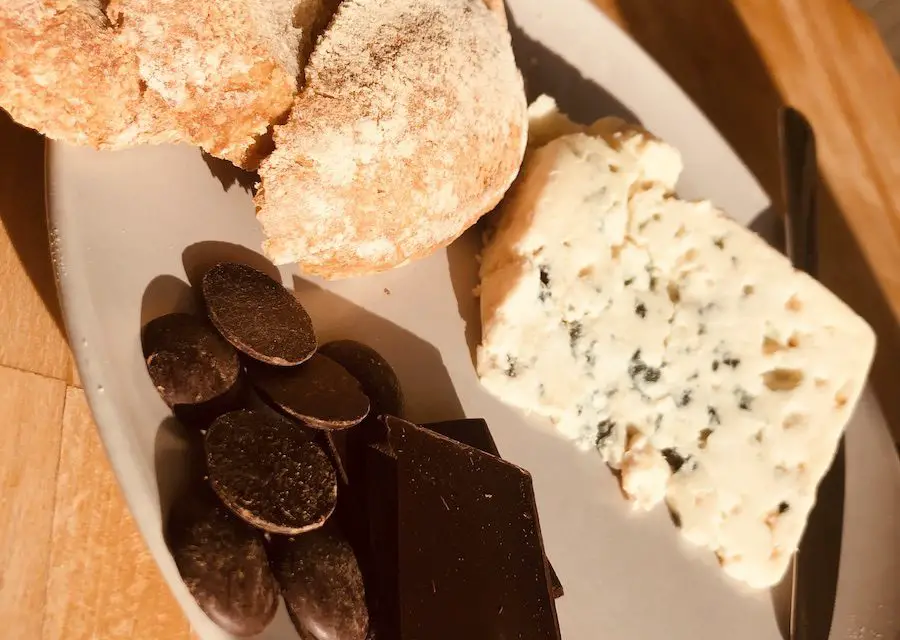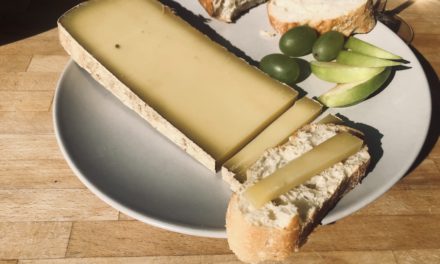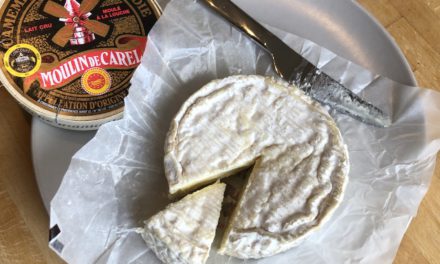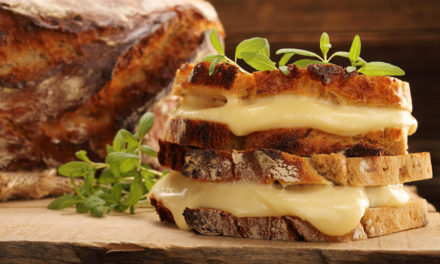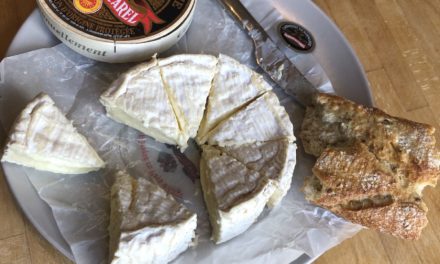France has one of the ideal geographies for the development of cheese, not for nothing it has more than 1200 varieties according to cheese fanatics. This is because it has a privileged location, during the summer it is not too hot and not too cold during the winter and the proof of this is the story of one of the most emblematic cheeses of this country. Roquefort cheese AOP. According to “L’institut national de l’origine et de la qualité, INAO“.
Roquefort cheese is an unctuous cheese of the blue cheese family, made exclusively from raw sheep’s milk. Its unpressed body is white in color with regular blue tones. It has a minimum dry matter content of 55% and a minimum fat content of approximately 28%. It has a very particular musty smell and a fine and pronounced odor.
The history of Roquefort begins in medieval times, in the Combalou mountain in the south of France, this mountain developed over time faults that created caves that are naturally ventilated throughout the year through air that the locals call “Fluerines”, which means “blowing” in Occitan language. In case you didn’t know Occitan is a Romance language that was spoken in the south of France, despite centuries of development of French as the official language of the country, even today Occitan is spoken by only a few people in the southern regions and certain words remain to this day in popular culture.
The “fluerines” are responsible for providing a fresh and humid air which, together with the darkness of the caves, create the perfect conditions for the development of the penicillium roqueforti mushroom in the cheese. So if you were wondering…
Why is Roquefort cheese blue?
The characteristic blue color of Roquefort cheese is given by the penicillium roqueforti mushroom.
What is penicillium roqueforti?
It is a microscopic mushroom that is added to cheese and in the case of Roquefort cheese gives it its flavor, aroma and mainly its characteristic blue color.
It is nowadays industrially produced, but in the village of Roquefort there are producers, e.g. the house of Carles, who grow their own penicillium roqueforti on rye bread in the old-fashioned way, which is great, isn’t it?
Where does Roquefort cheese come from?
Roquefort cheese is made in the south of France in the village of Roquefort sur Soulzon, department of Aveyron, Occitanie region.
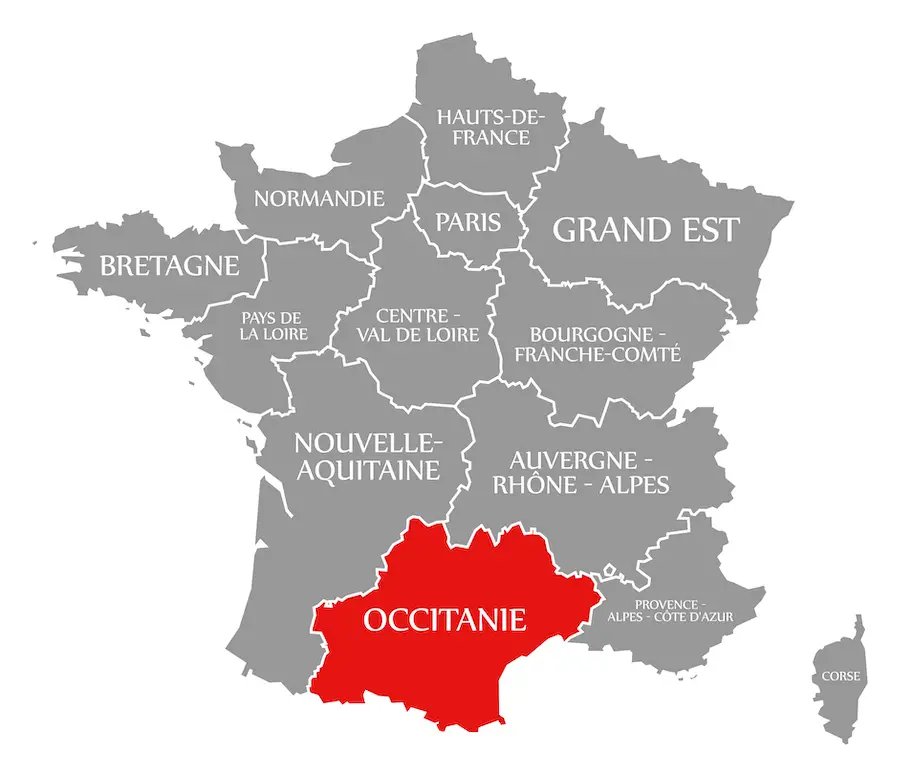
The origin of Roquefort cheese is not known exactly. As with many cheeses, there is a legend. In the case of the cheese in question, the story goes that a shepherd who was about to eat a loaf of rye bread with goat’s cheese saw a shepherdess passing by and decided to accompany her. When he returned weeks later, his cheese had turn in what would become the beginnings of the famous Roquefort cheese.
What is known for sure is that the cheese was consumed by the locals as early as the 11th century. Even different kings of France protected the manufacture of cheese in its place of origin through different laws developed from the 15th century onwards, granting a monopoly to that community.
Moving forward to modern times, in 1925 Roquefort cheese was the first cheese to obtain the “Appelation d’origine controlée” (AOC) certification in France and later it would also obtain “Appellation d’origine protégée” (AOP) certification from the European Union.
What is Roquefort cheese made of?
Roquefort cheese is made from raw sheep’s milk of the Lacaune breed.
This breed of sheep originates from the south of France. It was developed at the beginning of the last century to increase milk production and thus maintain cheese production.
What do the sheep whose milk is used to make Roquefort cheese eat?
The famous Lacaune ewes graze all year round, if weather conditions permit and grass is available, they must be grazed daily. In general, their feed is a mixture of grass, fodder, and cereals such as oats.
How is Roquefort cheese made?
Once the milk has been collected, it is taken to manufacturing centers. The first step is to raise the temperature of the milk to a maximum of 34ºC and add rennet. Once the milk is curdled, it is cut into small pieces, stirred, and molded without compacting and penicilium roqueforti is added. It is left to drain and then salted and pricked, an operation that consists of perforating the cheese so that air can enter the interior and thus help the mushroom to develop. After this process, the cheeses are taken to natural caves where they are stored for maturing at a temperature of between 8 and 12 degrees Celsius and a humidity of 98%.
Systematically a sample will be taken to check the development of the mushroom, at the right moment, determined by generations of experience, the cheese will be wrapped in a tin foil to stop the development of penicilium roqueforti and leave it to mature for another 1-2 months. At the end of this period of curing, the tin foil is removed, and the cheeses are packed for distribution.
How long is Roquefort cheese matured?
The ripening time of Roquefort cheese is at least 3 months, of which at least 14 days are “naked” without the tin foil.
How many kilograms of Roquefort cheese are produced per year?
In 2020, 16 012 tons of Roquefort cheese were commercialized.
That’s a lot of cheese! That’s more than 5 337 333 Roquefort cheese cylinders with an average weight of 3 kilograms, 20 centimeters in diameter and between 8.5 and 11.5 centimeters in height.
Of the 16,012 tonnes available for sales in 2020, France consumed around 12,009 tonnes, i.e. 75%. The remaining 25% (4 003 tonnes) were exported. According to data from the Confédération générale des producteurs de lait de brebis et des industriels de Roquefort.
In the case of Roquefort cheese, three things make it unique. The land, the milk, and the mushroom. The territory has created the maturing caves. The milk is influenced by the territory, the climate, and the vegetation available to the sheep. And finally, the mushroom, which gives it its flavor and aroma.
What a story!

